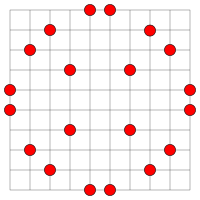No-three-in-line problem

The no-three-in-line problem is a puzzle where you have to place as many points as possible on a plane (like a piece of paper) in a way that no three points are in a straight line.
Imagine you have a bunch of toy cars, and you want to put as many of them as possible on a road map without any three cars being in a straight line. You start by placing one car on the map. Then you put another car somewhere else on the map, but it cannot be in a line with the first car. After that, you put a third car on the map, but it cannot lie in a straight line with the other two cars.
As you keep adding more and more cars, it gets harder and harder to find places to put them where they're not in a line. But if you're good at it, you can still fill up most of the map without breaking the rule.
This puzzle is important in computer science, because it's related to finding the maximum number of connections that can be made in a graph, which is a set of points interconnected by lines. It's also related to other mathematical problems, like the four color theorem, which says that you can color any map with four colors in a way that no two countries with the same color touch each other.
Imagine you have a bunch of toy cars, and you want to put as many of them as possible on a road map without any three cars being in a straight line. You start by placing one car on the map. Then you put another car somewhere else on the map, but it cannot be in a line with the first car. After that, you put a third car on the map, but it cannot lie in a straight line with the other two cars.
As you keep adding more and more cars, it gets harder and harder to find places to put them where they're not in a line. But if you're good at it, you can still fill up most of the map without breaking the rule.
This puzzle is important in computer science, because it's related to finding the maximum number of connections that can be made in a graph, which is a set of points interconnected by lines. It's also related to other mathematical problems, like the four color theorem, which says that you can color any map with four colors in a way that no two countries with the same color touch each other.
Related topics others have asked about:
